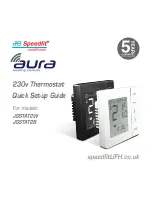
GB
8. Examples of calculations, self-heating of the sensor tip
14030069.01 12/2011 GB/D/F/E
WIKA operating instructions models TR10-W, TC10-W
15
8. Examples of calculations, self-heating of the sensor tip
The self-heating at the thermowell tip depends on the sensor type (measuring
resistor/thermocouple), the measuring insert diameter and the design of the
thermowell. The following table indicates the possible combinations. The heating
at the sensor tip of the bare measuring insert is considerably higher; as it must
be combined with a thermowell, these values are not shown. The table shows
that the self-heating of thermocouples is considerably lower than the self-heating
of resistance thermometers.
Thermal resistance [Rth in °K/W]
Measuring insert diameter
3 mm 6 mm 3 mm 6 mm
Sensor type
RTD
RTD
TC
TC
With multipart thermowell
(straight and tapered)
(e.g. TW30, TW35, TW40)
60
37
15
5
With solid thermowell (straight and tapered)
(e.g. TW10, TW15, TW20, TW25, TW30)
22
16
10
3
Mounted in a pocket hole
(minimum wall thickness 5 mm)
22
16
10
3
8.1 Calculation example for version 2, resistance thermometer
Use at the transition to zone 0, certification II 1/2G Ex d IIC T1-T6, power
limitation circuit by means of a 32 mA pre-fuse.
The maximum possible temperature T
max
at the thermowell tip for the following
combination must be determined:
RTD measuring insert Ø 6 mm with integral head-mounted transmitter, mounted
in a solid thermowell.
T
max
results from the addition of the medium temperature and the self-heating.
The self-heating depends on the supplied power P
o
and the thermal resistance
R
th
. The calculated supplied power P
o
results from the selected standard value
for the pre-fuse and is only active at the sensor tip.
Thus, the following formula applies: T
max
= P
o
x R
th
+ T
M
T
max
= Surface temperature (max. temperature at the thermowell tip)
P
o
=
0.8 W (pre-fuse with 32 mA, a complete short circuit of the transmitter is
assumed)
R
th
= Thermal resistance [K/W]
T
M
= Medium temperature
















































